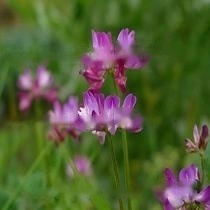
Chinese name: Ziyunying
Latin name: Astragalus sinicus L.
Alternative name: Qiaoyao, safflower, grass, etc.
Distribution area: Middle and lower reaches of the Yangtze River, Jianli, Hubei
1. Morphological characteristics of Astragalus.
Astragalus is a biennial herb, multi-branched and prostrate. And is covered with white sparsely pubescent, odd-pinnate compound leaves. Petiole shorter than rachis; stipules free, ovate, 3-6 mm long, apex pointed, base more or less connate with each other, ciliate; leaflet obovate or elliptic, end obtuse or slightly concave, base broadly cuneate, almost absent above Hair, with white pubescence scattered below, with short stalk. Pedicel axillary, longer than leaves; corolla purple or orange-yellow, flag petals obovate. The apex is slightly concave, the base is tapered into a stalk, and the wing petals are shorter than the flag petals. The petals are oblong, with short ears at the base, and the stalk is about 1/2 the length of the petals. The flowering period is from February to June, and the fruit period is from March to July.
2. Growth habit of Astragalus
Astragalus likes a warm climate, and generally has an obvious overwintering period. The seedling stage grows slowly below 8°C; after the beginning of spring, when the daily average temperature reaches above 6°C to 8°C, the growth rate is significantly accelerated. The optimum temperature for flowering and pod formation is 13°C to 20°C. Vetch grows well in moist and well-drained soil, and is afraid of drought and flooding. The most suitable soil moisture content for growth is 20% to 25%, and the soil is mainly light-textured loam. The fresh vetch grass can be silaged in cement cellars, earth cellars, polyethylene bags, cans and barrels, and can be popularized and applied in various places according to local conditions.
3. Cultivation of Astragalus
Astragalus can be used as green manure and fertile fields, and can also be used as green fodder to feed livestock and poultry. Planting good green manure can supplement nutrients to the soil, improve soil fertility, and lay a solid foundation for high and stable grain yields throughout the year. It is currently the sowing season of vetch. Before sowing, choose a sunny noon, spread the green manure seeds for 4-5 hours, add a certain amount of fine sand to wipe the seeds after drying, and wipe off the wax on the seed epidermis to improve the water absorption and germination rate of the seeds. Astragalus is afraid of both waterlogging and drought during the growth period, so special attention should be paid to it.
Guess you like it
Salvia | Cistanche | | Edelweiss| Cosmos|
Syringa | Venus flytrap| Wild strawberry| Cistanche|
gerbera | white grass | dendrobium | shegan | purple jasmine | duruo | zhe fritillary | petunia |
![[Dog Training 5] The training method of pet dog dining etiquette](/static/img/12192/12192_1.jpg)




